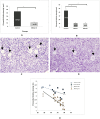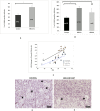Ovarian Aging in Women With BRCA Germline Mutations
- PMID: 28938488
- PMCID: PMC5630253
- DOI: 10.1210/jc.2017-00765
Ovarian Aging in Women With BRCA Germline Mutations
Abstract
Context: Recent clinical and laboratory studies suggested that women with BRCA mutations have lower ovarian reserve and their primordial follicle oocytes may be more prone to DNA damage; however, direct proof is lacking.
Objective: To determine whether women with germline BRCA mutations have reduced primordial follicle reserve and increased oocyte DNA damage.
Design: A comparative laboratory study of ovarian tissue obtained from unaffected BRCA mutation carriers (BMCs) vs age-matched organ donor cadavers.
Setting: Two academic centers.
Patients or other participants: Of the 230 ovarian specimens from BMCs, 18 met the study inclusion criteria. Healthy ovaries from 12 organ donor cadavers served as controls.
Intervention: Histology and immunohistochemical analysis on paraffin-embedded ovarian sections.
Main outcome measure(s): Primordial follicle density and the percentage of DNA double-strand break (DSB)-positive primordial follicle oocytes.
Results: Ovaries from BMCs had significantly lower primordial follicle densities than those of controls (11.2 ± 2.0 vs 44.2 ± 6.2 follicles/mm3; P = 0.0002). BRCA mutations were associated with increased DNA DSBs in primordial follicle oocytes (62% ± 5.2% vs 36% ± 3.4%; P = 0.0005). In subgroup analyses, both BRCA1 and BRCA2 mutations were associated with lower primordial follicle density (P = 0.0001 and 0.0030, respectively), and BRCA1 mutations were associated with higher DNA DSBs (P = 0.0003) than controls. The rates of follicle decline (R2 = 0.74; P = 0.0001) and DNA DSB accumulation (R2 = 0.70; P = 0.0001) appeared to be accelerated, particularly in primordial follicle oocytes of BMCs over age 30 years.
Conclusions: We provide direct evidence of diminished ovarian reserve as well as accelerated primordial follicle loss and oocyte DNA damage in women with BRCA mutations. These findings may further our understanding of ovarian aging, and be useful when counseling BMCs.
Copyright © 2017 Endocrine Society
Figures


Similar articles
-
BRCA-related ATM-mediated DNA double-strand break repair and ovarian aging.Hum Reprod Update. 2020 Jan 1;26(1):43-57. doi: 10.1093/humupd/dmz043. Hum Reprod Update. 2020. PMID: 31822904 Free PMC article. Review.
-
Do BRCA1 and BRCA2 gene mutation carriers have a reduced ovarian reserve? Protocol for a prospective observational study.BMJ Open. 2019 Nov 25;9(11):e033810. doi: 10.1136/bmjopen-2019-033810. BMJ Open. 2019. PMID: 31772111 Free PMC article.
-
Increased chemotherapy-induced ovarian reserve loss in women with germline BRCA mutations due to oocyte deoxyribonucleic acid double strand break repair deficiency.Fertil Steril. 2020 Jun;113(6):1251-1260.e1. doi: 10.1016/j.fertnstert.2020.01.033. Epub 2020 Apr 22. Fertil Steril. 2020. PMID: 32331767 Free PMC article.
-
BRCA1/2 gene mutations do not affect the capacity of oocytes from breast cancer candidates for fertility preservation to mature in vitro.Hum Reprod. 2019 Feb 1;34(2):374-379. doi: 10.1093/humrep/dey358. Hum Reprod. 2019. PMID: 30561604
-
The adult ovary at single cell resolution: an expert review.Am J Obstet Gynecol. 2025 Apr;232(4S):S95.e1-S95.e16. doi: 10.1016/j.ajog.2024.05.046. Am J Obstet Gynecol. 2025. PMID: 40253085 Review.
Cited by
-
Impact of BRCA1 and BRCA2 mutations on ovarian reserve and fertility preservation outcomes in young women with breast cancer.J Assist Reprod Genet. 2020 Mar;37(3):709-715. doi: 10.1007/s10815-019-01658-9. Epub 2019 Dec 24. J Assist Reprod Genet. 2020. PMID: 31872386 Free PMC article.
-
BRCA, infertility, and fertility preservation: a review for counseling.J Assist Reprod Genet. 2023 Mar;40(3):465-472. doi: 10.1007/s10815-023-02725-y. Epub 2023 Jan 25. J Assist Reprod Genet. 2023. PMID: 36695945 Free PMC article. Review.
-
Association Between Impairment of DNA Double Strand Break Repair and Decreased Ovarian Reserve in Patients With Endometriosis.Front Endocrinol (Lausanne). 2018 Dec 21;9:772. doi: 10.3389/fendo.2018.00772. eCollection 2018. Front Endocrinol (Lausanne). 2018. PMID: 30622513 Free PMC article.
-
Novel variants in women with premature ovarian function decline identified via whole-exome sequencing.J Assist Reprod Genet. 2020 Oct;37(10):2487-2502. doi: 10.1007/s10815-020-01919-y. Epub 2020 Aug 13. J Assist Reprod Genet. 2020. PMID: 32789750 Free PMC article.
-
Prophylactic Radical Fimbriectomy with Delayed Oophorectomy in Women with a High Risk of Developing an Ovarian Carcinoma: Results of a Prospective National Pilot Study.Cancers (Basel). 2023 Feb 10;15(4):1141. doi: 10.3390/cancers15041141. Cancers (Basel). 2023. PMID: 36831483 Free PMC article.
References
-
- Sung PA, Libura J, Richardson C. Etoposide and illegitimate DNA double-strand break repair in the generation of MLL translocations: new insights and new questions. DNA Repair (Amst). 2006;5(9-10):1109–1118. - PubMed
-
- Venkitaraman AR. Cancer susceptibility and the functions of BRCA1 and BRCA2. Cell. 2002;108(2):171–182. - PubMed
-
- Antoniou A, Pharoah PD, Narod S, Risch HA, Eyfjord JE, Hopper JL, Loman N, Olsson H, Johannsson O, Borg A, Pasini B, Radice P, Manoukian S, Eccles DM, Tang N, Olah E, Anton-Culver H, Warner E, Lubinski J, Gronwald J, Gorski B, Tulinius H, Thorlacius S, Eerola H, Nevanlinna H, Syrjäkoski K, Kallioniemi OP, Thompson D, Evans C, Peto J, Lalloo F, Evans DG, Easton DF. Average risks of breast and ovarian cancer associated with BRCA1 or BRCA2 mutations detected in case series unselected for family history: a combined analysis of 22 studies. Am J Hum Genet. 2003;72(5):1117–1130. - PMC - PubMed
Publication types
MeSH terms
Substances
Grants and funding
LinkOut - more resources
Full Text Sources
Other Literature Sources
Medical
Miscellaneous

